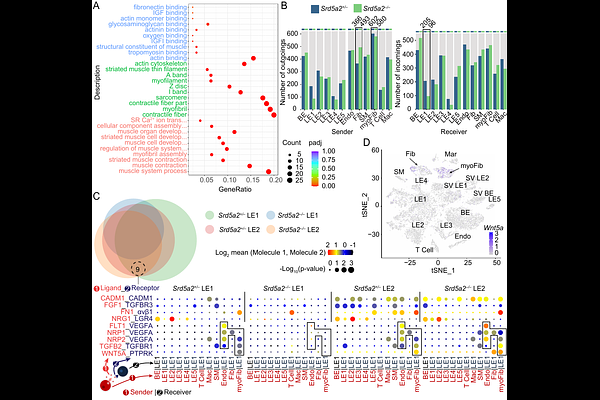Stromal SRD5A2 promotes prostate growth through WNT5A-LEF1-IGF1 signaling in benign prostatic hyperplasia

Stromal SRD5A2 promotes prostate growth through WNT5A-LEF1-IGF1 signaling in benign prostatic hyperplasia
Sharkey, C.; Gu, B.; Long, X.; Tang, Y.; Patsatzis, N.; Li, S.; Olumi, A. F.; wang, z.
AbstractBackground: Steroid 5-reductase type 2 (SRD5A2) is a key enzyme in androgen metabolism and a pharmacologic target in benign prostatic hyperplasia (BPH). While SRD5A2 is known to mediate stromal-epithelial interactions that influence prostate growth, the relationship between baseline SRD5A2 expression and prostate volume remains unclear. Methods: We analyzed SRD5A2 expression in human prostate tissues from two independent cohorts: the Medical Therapy of Prostatic Symptoms (MTOPS) trial and an institutional biorepository. Quantitative assessments were performed using immunohistochemistry, quantitative PCR, ELISA, and western blotting. Correlations were evaluated between SRD5A2 expression, WNT5A expression, prostate volume, and tissue signaling profiles. Functional validation was performed in a Srd5a2-null mouse model and through mechanistic studies using stromal cell SRD5A2-overexpression systems. Results: SRD5A2 expression was significantly associated with total prostate and transition zone volume in both human cohorts. Stromal-specific WNT5A expression showed a strong positive correlation with SRD5A2, while neither serum nor tissue dihydrotestosterone levels correlated with SRD5A2 expression. In Srd5a2-null mice, Wnt5a expression in the prostate stroma was dependent on Srd5a2 and showed region-specific regulation. Mechanistically, SRD5A2 overexpression in stromal cells upregulated WNT5A and Lymphoid Enhancer-Binding Factor 1 (LEF1), activated insulin-like growth factor 1 (IGF1) signaling, increased proliferation, and reduced apoptosis. Conditioned media from these cells enhanced epithelial proliferation through paracrine IGF1 activity, independent of epithelial WNT signaling. Conclusions: This study provides the first evidence that SRD5A2 promotes prostate growth through a stromal WNT5A-LEF1-IGF1 paracrine signaling axis, functioning independently of androgen levels. These findings suggest a novel therapeutic mechanism relevant for BPH patients with resistance to conventional 5-reductase inhibitor therapy.